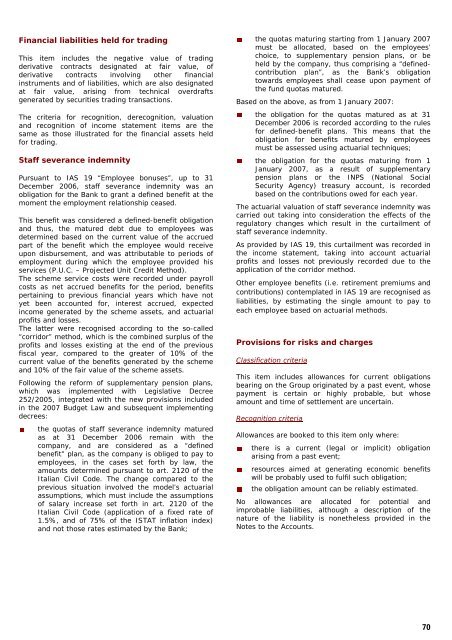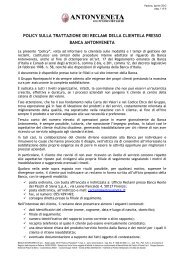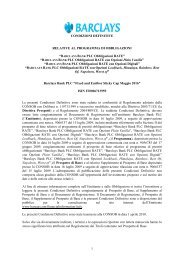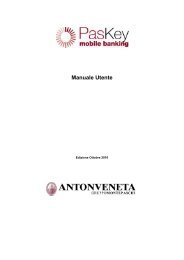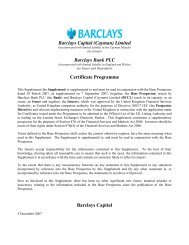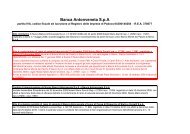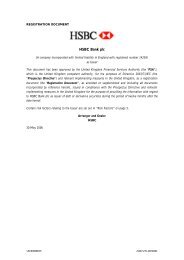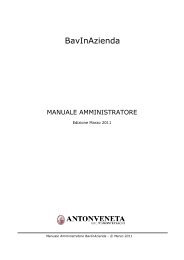996 - Banca Antonveneta
996 - Banca Antonveneta
996 - Banca Antonveneta
You also want an ePaper? Increase the reach of your titles
YUMPU automatically turns print PDFs into web optimized ePapers that Google loves.
Financial liabilities held for tradingThis item includes the negative value of tradingderivative contracts designated at fair value, ofderivative contracts involving other financialinstruments and of liabilities, which are also designatedat fair value, arising from technical overdraftsgenerated by securities trading transactions.The criteria for recognition, derecognition, valuationand recognition of income statement items are thesame as those illustrated for the financial assets heldfor trading.Staff severance indemnityPursuant to IAS 19 “Employee bonuses”, up to 31December 2006, staff severance indemnity was anobligation for the Bank to grant a defined benefit at themoment the employment relationship ceased.This benefit was considered a defined-benefit obligationand thus, the matured debt due to employees wasdetermined based on the current value of the accruedpart of the benefit which the employee would receiveupon disbursement, and was attributable to periods ofemployment during which the employee provided hisservices (P.U.C. – Projected Unit Credit Method).The scheme service costs were recorded under payrollcosts as net accrued benefits for the period, benefitspertaining to previous financial years which have notyet been accounted for, interest accrued, expectedincome generated by the scheme assets, and actuarialprofits and losses.The latter were recognised according to the so-called“corridor” method, which is the combined surplus of theprofits and losses existing at the end of the previousfiscal year, compared to the greater of 10% of thecurrent value of the benefits generated by the schemeand 10% of the fair value of the scheme assets.Following the reform of supplementary pension plans,which was implemented with Legislative Decree252/2005, integrated with the new provisions includedin the 2007 Budget Law and subsequent implementingdecrees:the quotas of staff severance indemnity maturedas at 31 December 2006 remain with thecompany, and are considered as a “definedbenefit” plan, as the company is obliged to pay toemployees, in the cases set forth by law, theamounts determined pursuant to art. 2120 of theItalian Civil Code. The change compared to theprevious situation involved the model’s actuarialassumptions, which must include the assumptionsof salary increase set forth in art. 2120 of theItalian Civil Code (application of a fixed rate of1.5%, and of 75% of the ISTAT inflation index)and not those rates estimated by the Bank;the quotas maturing starting from 1 January 2007must be allocated, based on the employees’choice, to supplementary pension plans, or beheld by the company, thus comprising a “definedcontributionplan”, as the Bank’s obligationtowards employees shall cease upon payment ofthe fund quotas matured.Based on the above, as from 1 January 2007:the obligation for the quotas matured as at 31December 2006 is recorded according to the rulesfor defined-benefit plans. This means that theobligation for benefits matured by employeesmust be assessed using actuarial techniques;the obligation for the quotas maturing from 1January 2007, as a result of supplementarypension plans or the INPS (National SocialSecurity Agency) treasury account, is recordedbased on the contributions owed for each year.The actuarial valuation of staff severance indemnity wascarried out taking into consideration the effects of theregulatory changes which result in the curtailment ofstaff severance indemnity.As provided by IAS 19, this curtailment was recorded inthe income statement, taking into account actuarialprofits and losses not previously recorded due to theapplication of the corridor method.Other employee benefits (i.e. retirement premiums andcontributions) contemplated in IAS 19 are recognised asliabilities, by estimating the single amount to pay toeach employee based on actuarial methods.Provisions for risks and chargesClassification criteriaThis item includes allowances for current obligationsbearing on the Group originated by a past event, whosepayment is certain or highly probable, but whoseamount and time of settlement are uncertain.Recognition criteriaAllowances are booked to this item only where:there is a current (legal or implicit) obligationarising from a past event;resources aimed at generating economic benefitswill be probably used to fulfil such obligation;the obligation amount can be reliably estimated.No allowances are allocated for potential andimprobable liabilities, although a description of thenature of the liability is nonetheless provided in theNotes to the Accounts.70


